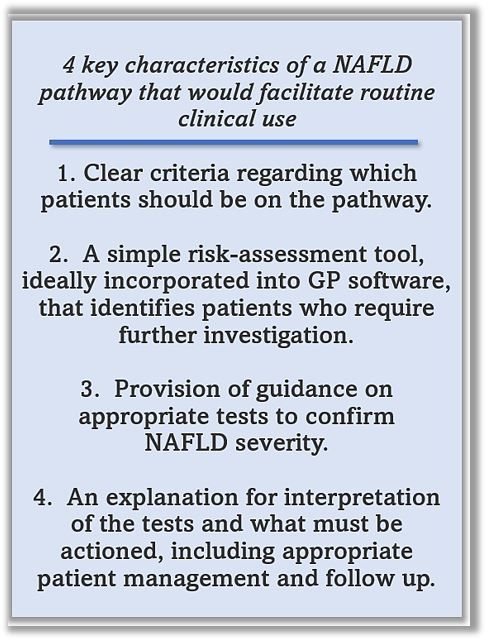- Clinical Technology
- Adult Immunization
- Hepatology
- Pediatric Immunization
- Screening
- Psychiatry
- Allergy
- Women's Health
- Cardiology
- Pediatrics
- Dermatology
- Endocrinology
- Pain Management
- Gastroenterology
- Infectious Disease
- Obesity Medicine
- Rheumatology
- Nephrology
- Neurology
- Pulmonology
Call for a NAFLD Care Pathway in T2D in Primary Care
Integrating NAFLD as a diabetes complication to be addressed during routine cycles of care could reduce barriers to a NAFLD pathway in primary care, agreed focus group participants.
©wowow/stock.adobe.com

Nonalcoholic fatty liver disease (NAFLD) is overlooked in management of type 2 diabetes (T2D) and should be formally addressed in routine primary care pathways.
The imperative comes from researchers in Australia who say that the approach by clinicians to NAFLD and risk stratification in people with T2D is inconsistent and that determinants of clinician behavior around the management of the disease "remain unclear."
The recent inquiry into barriers and potential solutions to closing the gap in clinical practice was published in Diabetic Medicine.
The research team, led by Elizabeth Powell, professor in the School of Medicine and The University of Queensland, write that NAFLD is the most common chronic hepatic disorder seen in primary care and prevalence in persons with T2D ranges from ~47% to 64%. They state further that while community screening for NAFLD is not currently endorsed, the American Diabetes Association now recommends an evaluation for NAFLD in people with T2D and hepatic steatosis or poor liver enzymes. The dangers of undetected NAFLD, and particularly nonalcoholic steatohepatitis (NASH), are well known and, at the extreme, include hepatocellular carcinoma.
To better understand the feasibility of integrating NAFLD as a diabetes complication to be addressed during "established cycles of care," Powell and colleagues conducted focus groups with 24 health care professionals; usable content for analysis was generated by 19 participants, 9 general practitioners, 7 endocrinologists, and 3 diabetes educators (13 women). Transcripts were evaluated using thematic analysis.
Ultimately themes were grouped to reflect the 2 key stages of a NAFLD pathway, diagnosis and assessment and management.

Knoweldge, beliefs, perceptions
The participants underscored the high prevalence of NAFLD among their patients with T2D noting that without a structured pathway to follow, identifying and treating the disease could “result in an overwhelming burden on health services.”
None of the participants had a “consistent workup” to follow in a suspected case of liver disease; also, they expressed uncertainty about appropriate assessment for NAFLD and many were aware that progression to long-term complications was rare.These issues compounded by a perceived absence of effective treatment for NAFLD, the need to focus on other conditions while constrained by limited time and resources, led to a tendency to deprioritize NAFLD.
Powell et al report that participants also detailed challenges in communicating with patients about NAFLD that included not wanting to overwhelm them with information that might then leave them confused about managing their other health concerns.
NAFLD management by proxy
The health care providers’ perceived inability to monitor NAFLD and its comorbidity with other metabolic derangements influenced decisions on how to focus patient management, the authors said. Two examples were support for weight loss and actively monitoring cardiovascular disease (CVD) risk, the former understood as treatment for NAFLD, and the latter based on awareness that CVD is a leading cause of mortality in NAFLD.
The researchers add, that despite a general feeling of futility about investigating for NAFLD, “participants acknowledged that patient awareness and understanding of liver disease and cancer risk was important to motivate lifestyle changes.”
Overall, write Powell and team, it was a combination of practitioner lack of knowedge and access to resources driving inconsistency in NAFLD diagnosis and care, deficits that also reduced confidence to discuss the disease with patients.
Pathways in primary care
Specialists in the group felt that their role was to provide disease management expertise and that NAFLD interventions would be best implemented and followed in primary care, a belief supported by the general practitioners. All participants recommended including NAFLD management as part of routine metabolic assessment to “reinforce the shared features of these conditions.”
Powell and team add that the paradigm shift in diabetes management to focus on preventing complications vs on A1c targets could facilitate inclusion of a NAFLD pathway in primary care.
They conclude: “By focusing on comorbidity prevention and integrating NAFLD as a diabetes complication to be addressed during established cycles of care, many barriers to implementing a NAFLD pathway in primary care could be overcome.”
Reference: Gracen L, Hayward LK, Aikebuse M, et al. An exploration of barriers and facilitators to implementing a nonalcoholic fatty liver disease pathway for people with type 2 diabetes in primary care. Diabetic Medicine. Published online ahead of print January 31, 2022.
